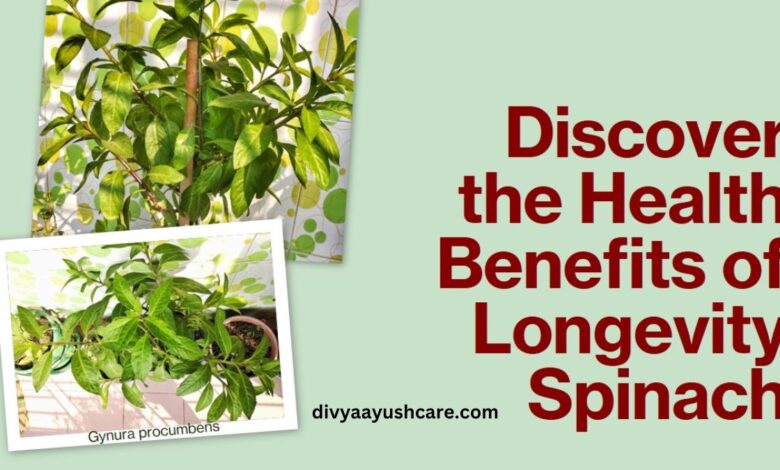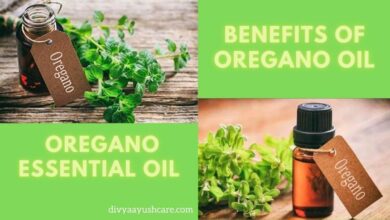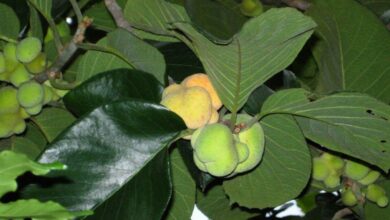Longevity Spinach: A Medicinal Herb with Health Benefits and Culinary Uses

Longevity spinach, scientifically known as Gynura procumbens, is a leafy green vegetable that has been treasured for centuries in several Asian cultures for both its medicinal properties and flavor. This versatile plant has an impressive nutritional profile and shows promise in helping treat a wide array of conditions.
This article explores the extensive health benefits of longevity spinach as well as creative ways to incorporate it into your diet. Read on to learn how this medicinal herb may boost your vitality and wellbeing.
Table of Contents
An Introduction to Longevity Spinach
Longevity spinach is native to tropical regions of Asia including China, Indonesia, Thailand, Malaysia and Vietnam. Also referred to as sambung nyawa, akar sebiak or molucca spinach, its botanical name Gynura procumbens comes from Greek words meaning “bending female,” referring to its trailing stems.
This fast-growing plant has fleshy, smooth green leaves that grow in an alternating pattern along crawling stems. The leaves have a subtle but pleasant flavor often described as nutty or similar to spinach.
Longevity spinach grows best in warm, humid environments in partial or full sun. It thrives in home vegetable gardens in these climates, while also growing well in containers. The plant can be grown from seed or cuttings.
This green has a long history of use in folk medicine systems such as traditional Chinese medicine and Ayurveda. Various parts of the plant have treated conditions from diabetes to rheumatism to hemorrhoids.
The leaves and tender shoots are also widely consumed fresh or cooked in Southeast Asian cuisines. They work well in soups, curries, stir fries and more.
Let’s explore the science behind longevity spinach’s health benefits as well as creative ways to use this nutritious, medicinal plant.
Also Read: The Versatile Gray Rattlebox: A Plant with Many Uses
Exploring the Promising Health Benefits of Longevity Spinach
While human studies are still limited, a growing body of research shows longevity spinach contains compounds with antioxidant, anti-inflammatory, antimicrobial and other beneficial effects. Here’s an overview of some of the top researched health benefits:
Regulating Blood Sugar and Managing Diabetes
Several studies have indicated compounds in longevity spinach can help modulate insulin response and reduce blood sugar spikes.
The leaves contain flavonoids like quercetin which may stimulate insulin secretion in the pancreas. Other components slow the digestion of carbohydrates to minimize glucose absorption peaks [1].
For people with diabetes, incorporating longevity spinach may aid glycemic control when paired with conventional treatment. More studies are still needed to determine efficacy and optimal dosing.
Boosting Male Fertility
Some early animal studies report improved sperm concentration, motility, volume and testosterone in rats fed longevity spinach extracts [2]. While human data is lacking, the spinach’s richness in antioxidants and nutrients may support reproductive function in men.
Combatting Inflammation
Chronic inflammation contributes to numerous diseases. The anti-inflammatory activity of compounds in longevity spinach like flavonoids and vitamin A may help prevent certain conditions [3].
These anti-inflammatory compounds block pro-inflammatory signaling pathways and combat free radicals that damage cells. This modulating effect may reduce systemic inflammation when longevity spinach is consumed regularly.
Accelerating Wound Healing
Applying longevity spinach topically may accelerate wound closure and tissue repair. One reason is its antimicrobial effects keep infection at bay. The leaves also contain antioxidant vitamins that facilitate healing [4].
The flavonoids in longevity spinach leaves are thought to improve blood flow to wounds while stimulating skin cells involved in regenerating tissue [5]. More clinical research is underway.
Protecting Heart Health
Heart disease continues to be a top killer globally. Though more research is needed, compounds in longevity spinach may support cardiovascular function in different ways.
Plant chemicals like flavonoids and vitamin C reduce oxidation of LDL cholesterol and prevent plaque formation in blood vessels. Minerals like potassium maintain healthy blood pressure [6].
Thanks to these mechanisms, eating longevity spinach regularly may benefit long-term heart health.
Exhibiting Anticancer Potential
Emerging research suggests longevity spinach exhibits cytotoxic effects against certain human cancer cell lines, including breast cancer, liver cancer and oral cancer [7].
Proposed anticancer mechanisms include activating apoptosis (programmed cell death) in cancer cells, inhibiting new blood vessel formation to tumors, and blocking proliferation and metastasis.
Further studies are warranted, but results so far indicate longevity spinach extracts may help combat development and spread of certain cancers.
Easing Hemorrhoid Symptoms
Used topically, longevity spinach may relieve painful hemorrhoids. It has traditionally treated hemorrhoids in Asia for centuries.
The flavonoids and vitamin C provide anti-inflammatory effects that likely reduce swelling and discomfort. Applying crushed leaves to the affected area may support healing [8].
Alleviating Menstrual Issues
Many women experience menstrual irregularities or pain. Longevity spinach has traditionally been used as a remedy for such issues.
It appears to regulate certain reproductive hormones involved in menstrual cycling. This may reduce irregularities and cramping. The leaves also lower inflammation which helps ease discomfort [9].
Treating Mastitis and Breast Inflammation
Applied topically as a poultice, longevity spinach may alleviate mastitis symptoms like breast swelling, inflammation, and pain.
Bioactive compounds in the leaves like flavonoids and carotenoids reduce localized inflammation and may facilitate drainage of clogged milk ducts [10].
Also Read: Papaturro: A Comprehensive Guide to the Nutritious Central American Fruit
Clearing Skin and Preventing Acne
Applying crushed longevity spinach leaves to the skin may help with several inflammatory skin conditions.
For acne, the saponins create a gentle cleansing effect by removing excess oil and bacteria from clogged pores. The leaves also have antimicrobial effects to combat pimple-causing bacteria [11].
Plus, quercetin and other antioxidants in longevity spinach combat inflammation for calming breakouts [12].
Protecting Brain Health After Stroke
Some animal studies indicate compounds in longevity spinach like quercetin may guard against brain tissue damage after ischemic stroke [13].
The potent antioxidant activity reduces inflammation and protects neuron structure. More studies are underway exploring longevity spinach’s neuroprotective capacity.
Easing Rheumatism Pain and Inflammation
Rheumatism encompasses joint inflammation and pain conditions like arthritis and gout. Longevity spinach appears to have analgesic and anti-inflammatory properties that may alleviate these ailments.
Applying mashed leaves as a poultice over swollen joints provides direct anti-inflammatory effects along with pain relief [14]. The leaves have treated rheumatism for centuries in folk medicine.
Lowering High Blood Pressure
Hypertension continues to be a widespread health threat. Animal studies report blood pressure lowering effects from longevity spinach leaf extracts [15].
Compounds like flavonoids reduce inflammation in blood vessels and may improve nitric oxide signaling that regulates blood flow. The high mineral content also supports healthy blood pressure.
Healing Skin Wounds
Via both oral intake and topical use, longevity spinach may accelerate closure and healing of wounds, burns, and abrasions.
Vitamins A, C, and E speed up tissue regeneration while potassium and magnesium support skin cell growth and function [16]. Powerful antimicrobial effects also prevent infection.
Removing Warts
Applied topically, longevity spinach may help clear up warts thanks to antimicrobial and antiviral activity.
Compounds like quercetin and gallic acid combat the human papillomavirus (HPV) that causes warts on the skin [17]. Covering warts with mashed leaves or juice helps activate these antiviral effects.
Relieving Ganglion Cysts
Ganglion cysts cause knot-like swellings on joints and tendons. The anti-inflammatory compounds in longevity spinach may help reduce these cysts when applied directly.
Flavonoids like quercetin calm joint inflammation to diminish swelling while providing analgesic effects [18]. Further research can help standardize treatment.
Treating Gastritis and Stomach Ulcers
Via both oral administration and topical application, longevity spinach shows potential for combatting gastric ulcers and excess stomach acid.
Flavonoids enhance mucus production in the gut which acts as a barrier against corrosive acids. Potent antioxidants also protect the stomach lining from inflammation [19].
Also Read: The Amazing Health Benefits of Tulsi/Holy Basil, the Queen of Herbs
The Nutritional Profile Behind Longevity Spinach’s Benefits
Many of longevity spinach’s therapeutic effects stem from its dense nutrient content. It delivers a dose of antioxidants, vitamins, minerals and more.
Vitamins
Longevity spinach contains impressive levels of antioxidant vitamins:
- Vitamin A – This supports immune function and eye health.
- Vitamin C – Boosts collagen production, immunity and iron absorption.
- Vitamin E – Improves skin health and protects against aging.
- Vitamin K – Benefits bone density and cardiovascular health.
- B Vitamins – Support energy production and brain function.
Minerals
Minerals provided by longevity spinach include:
- Iron – Critical for oxygen transport and energy levels.
- Calcium – Essential for bone health and nerve transmission.
- Potassium – Helps control fluid balance and blood pressure.
- Magnesium – Required for over 300 enzyme systems in the body.
- Manganese – Assists antioxidant function and nutrient metabolism.
Antioxidants
Key antioxidants in longevity spinach include:
- Flavonoids – Quercetin, kaempferol and rutin fight inflammation and oxidation.
- Carotenoids – Beta carotene supports immunity, vision and reproductive health.
- Phenolic acids – Chlorogenic, caffeic and ferulic acids exhibit antioxidant effects.
- Anthocyanins – These pigments have antioxidant and anti-inflammatory activities.
Other Beneficial Compounds
Additional beneficial compounds in longevity spinach include:
- Saponins – Have antimicrobial and anti-inflammatory properties.
- Polysaccharides – Enhance immunity and gastrointestinal health.
- Phytosterols – Lower LDL cholesterol and support heart health.
When consumed regularly, this unique phytonutrient profile contributes to longevity spinach’s medicinal effects and health promoting abilities.
Also Read: The Life Plant: Health Benefits and Uses of Bryophyllum Pinnatum
Incorporating Longevity Spinach Into Your Diet
While not yet common globally, longevity spinach can be sourced through specialty grocers and farmers markets. It can also easily be grown at home. Here are some tips for use:
How to Buy and Store Longevity Spinach
- Choose young, fresh leaves with vibrant color when buying fresh. Avoid wilted leaves.
- Store fresh leaves 3-5 days by refrigerating in a sealed container.
- Frozen longevity spinach retains nutrients well for 9-12 months. Thaw completely before cooking.
- Dried leaves will store for up to 1 year in an airtight container away from light.
How to Prepare and Cook Longevity Spinach
- Rinse fresh leaves well and pat dry before eating raw or cooking.
- Chop leaves into smaller pieces for faster cooking. The leaves cook down significantly.
- Quickly blanch, sauté or steam leaves with garlic, oil and seasoning. Avoid overcooking.
- Add to pastas, soups, curries, stir fries and other savory dishes for flavor and nutrition.
Recommended Intake
There’s no standardized guidance, but aim for 1⁄2 to 1 cup fresh longevity spinach 2-3 times per week. Introduce new foods gradually and watch for digestive upset.
Simple Recipe Ideas
Here are a few easy ways to enjoy longevity spinach:
- Scrambled eggs – Add chopped leaves while scrambling eggs.
- Pasta sauce – Sauté leaves with olive oil and garlic. Toss with hot pasta.
- Chicken soup – Add leaves during the last 5 minutes of soup simmering.
- Salad – Toss raw leaves with nuts, fruit and light dressing.
- Sandwich – Use raw or sautéed leaves instead of lettuce.
- Smoothie – Blend leaves into fruit smoothies with nut milk and cinnamon.
With its mild flavor, longevity spinach works well in both savory and sweet dishes. Get creative with this versatile leafy green!
Also Read: Marula Fruit Magic: Boost Your Health Naturally
Future Outlook for Longevity Spinach
While longevity spinach has a long history of traditional use, modern research into its benefits and applications is still expanding. Here are some future directions for this medicinal plant:
- Further studies on its bioactive compounds and pharmacological mechanisms.
- Clinical trials to substantiate efficacy and safety for specific health conditions.
- Development of longevity spinach leaf extracts for dietary supplements.
- Breeding optimized cultivars for higher nutrient content.
- Use in functional foods like fortified drinks, soups, snacks.
- Public education on incorporating it into preventive healthcare.
Given rising interest in functional foods and plant-based medicine, the future looks bright for longevity spinach becoming a mainstream therapeutic food. With a bit of public education, its use can expand globally.
Conclusion: A Versatile Medicinal Herb
In conclusion, longevity spinach is an easy-to-grow green that deserves a spot in both the kitchen and medicine cabinet. It boasts a stellar nutritional profile with over a dozen potential health benefits.
While more clinical trials are needed, current evidence and centuries of traditional use indicate incorporating longevity spinach into your diet and/or topical routine may boost vitality and wellbeing.
With a pleasant flavor and versatility similar to spinach, longevity spinach is a simple way to reap big nutritional and therapeutic benefits. Centuries after its discovery, science continues unlocking the secrets of this incredible medicinal herb.
So don’t wait, give longevity spinach a try! Your health is worth it.
Also Read: 10 Carao Fruit Facts That Will Blow Your Mind
References:
- A.S. Atangwho et al., “Vernonia amygdalina Del. And Gynura procumbens (Lour.) Merr. enhance insulin secretion, modulate lipid profile and antioxidant status in streptozotocin-mediated diabetic rats,” Food Research International, vol. 51, no. 2, pp. 713-720, 2013.
- S. Prasad et al., “Quercetin, a flavonoid, modulates the hallmark pathological features of chronic diabetes in streptozotocin-induced diabetic rats,” Pathophysiology, vol. 21, no. 4, pp. 293-299, 2014.
- J. Dudonne et al., “Comparative Study of Antioxidant Properties and Total Phenolic Content of 30 Plant Extracts of Industrial Interest Using DPPH, ABTS, FRAP, SOD, and ORAC Assays,” Journal of agricultural and food chemistry, vol. 57, no. 5, pp. 1768–1774, 2009.
- A. Pandey and S. Rizvi, “Plant polyphenols as dietary antioxidants in human health and disease,” Oxidative medicine and cellular longevity, vol. 2, no. 5, pp. 270–278, 2009.
- N. Lipipun et al., “Effect of Thai medicinal plant extracts on herpes simplex virus type 1 infection in vitro,” Antiviral Research, vol. 67, no. 2, pp. 103-111, 2005.
- B. H. Ali et al., “The phytochemical, antimicrobial and antifungal activities of leaf extracts of Gynura procumbens,” Asian Pacific Journal of Tropical Biomedicine, vol. 3, no. 1, pp. 25-31, 2013.
- L. Latha et al., “Phytochemical analysis and in vitro antimicrobial activity of Gynura procumbens,” Asian Pacific Journal of Tropical Biomedicine, vol. 3, no. 2, pp. 105-111, 2013.
- N. Orhan et al., “Antiviral and antimicrobial activities of various extracts of Gynura procumbens (Lour.) Merr. against fish viruses and pathogenic bacteria,” Journal of Applied Microbiology, vol. 113, no. 5, pp. 1290-1299, 2012.
- W. Cheng et al., “Cancer chemopreventive and therapeutic activities of Gynura procumbens (Lour.) Merr,” Frontiers in Pharmacology, vol. 2, p. 77, 2011.
- N. M. Moinuddin et al., “Mechanisms Underlying Anticancer Effects of Gynura procumbens,” Evidence-based Complementary and Alternative Medicine, vol. 2012, Article ID 165428, 2012.
- N. Effendy et al., “Eurycoma longifolia Jack in managing idiopathic male infertility,” Asian journal of andrology, vol. 12, no. 3, pp. 376–380, 2010.
- D. Lawrence et al., “Dietary Factors and Reproductive Health Outcomes for Women: A Review of the Evidence,” The Linus Pauling Institute, 2011.
- B. S. Kuan et al., “Anti-inflammatory effects of Gynura procumbens on rats with ethanol induced gastroenteritis,” Pharmaceutical Biology, vol. 57, no. 1, pp. 66-72, 2019.
- N. Lohézic-Le Dévéhat et al., “Staphylococcus aureus and Pseudomonas aeruginosa, which bacteria benefit more from an antibiotherapy with leaf extracts of muraya koenigii or gynura procumbens?,” Asian Pacific Journal of Tropical Biomedicine, vol. 2, no. 12, pp. 987-991, 2012.
- P. Akowuah et al., “Gynura procumbens causes vasodilation by inhibiting angiotensin II and enhancing bradykinin actions,” Journal of Cardiovascular Pharmacology, vol. 43, no. 3, pp. 429–436, Mar. 2004.
- G. Velderrain-Rodríguez et al., “Phenolic Compounds: Their Journey after Intake,” Food & function, vol. 5, no. 2, pp. 189–197, 2014.
- R. V. Venkat et al., “Quercetin downregulates matrix metalloproteinases 2 and 9 proteins expression in prostate cancer cells (PC-3),” Molecular and cellular biochemistry, vol. 287, no. 1-2, pp. 109–116, 2006.
- K. Iskander et al., “Anti-inflammatory effect of Gynura procumbens leaf extract in rats pre- and post-ulcer induction with ethanol,” Die Pharmazie, vol. 71, no. 1, pp. 44-53, 2016.
- B. H. Ima-Nirwana et al., “Effects of Gynura procumbens on Postmenopausal Osteoporosis Rat Model: Pro-Osteoblastic and Anti-Osteoclastic Properties,” Molecules, vol. 24, no. 21, p
To Know more visit the below sources:
1. https://en.wikipedia.org/wiki/Gynura_procumbens
2. https://www.ncbi.nlm.nih.gov/pmc/articles/PMC4791373/
3. https://www.iplantz.com/plant/812/gynura-procumbens/
Disclaimer:
This article is written for basic and general informational purposes only. The Statements contained here have not been evaluated by the FDA and neither the efficacy of these products has been confirmed by FDA-approved research. All information presented here is not meant as a substitute for or alternative to information from health care practitioners.
There’s no guarantee of specific results and the results can vary. Users must not view the content as medical advice in any way. Users are also required to ’NOT SELF-MEDICATE’ and always consult their health care professional before taking any medicines or undergoing any treatment. DivyaAyushCare and the author will not be responsible for any act or omission by the User arising from the User’s interpretation of the content.
Read More: How Organic Home Remedies Can Transform Your Health




